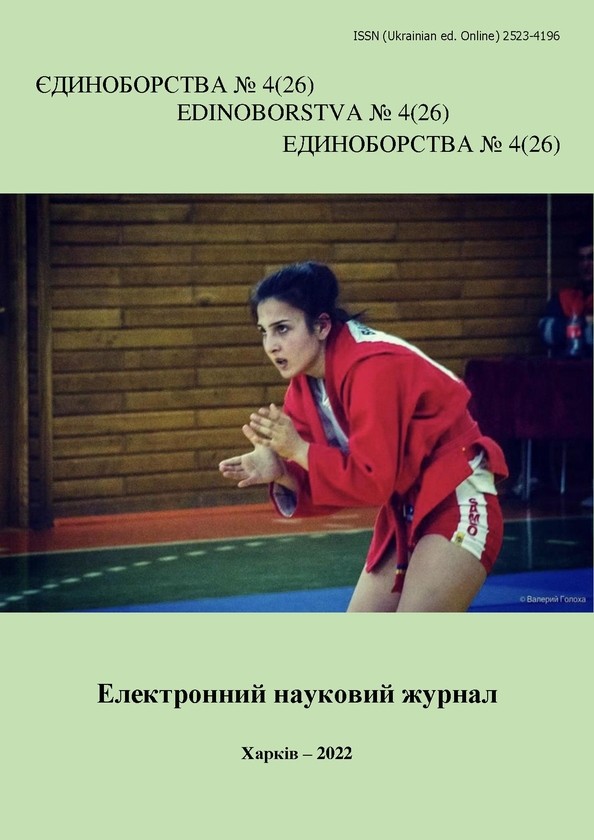Teaching martial arts students to run 1500 m using rhythmic stimulation
DOI:
https://doi.org/10.15391/ed.2022-4.02Keywords:
running, training, cadence, MAV, VO2max, pace, rhythm, martial arts, preparednessAbstract
Purpose: to investigate the effectiveness of teaching martial arts
students to run 1500 m using rhythmic stimuli. Material and methods. The following methods of
pedagogical research were used to solve the research tasks: theoretical (analysis, synthesis,
comparison, generalization of abstraction) and practical (observation, testing, experiment, mathematical and statistical). Martial arts students aged 18,5±0,5 years of the II year of full-time
education took part in the study (n=20). Results: іndicators indicating the economy of a runner's
movement were selected as characteristics that determine mastery of running technique: MAV –
maximum aerobic speed; VO2max is the maximum rate of oxygen absorption. We believe that in
conditions of limited time for running training (8 classes), the very increase in running efficiency
indicates the athlete's understanding of the essence of this motor action. As a stimulating factor in
the experimental running training program of martial arts students, running with a metronome was
used with a given frequency, which increased in each session from 157 beats/min. up to 165
beats/min. The students had to run first, synchronizing their steps with the metronome, and after
rest, reproduce the learned rhythm without external stimulation. The martial arts athletes of the
control group studied running according to the traditional program for the same amount of time.
The result of the study was significantly (p<0,05) higher indicators of running cadence and results
of running at the reference distance of 1500 m in the group of martial arts students who practiced
using rhythmic stimuli. At the same time, there were no significant differences in the MAV and
VO2max indicators in the wrestlers of both groups during the entire study period (p>0,05). This
indicates the effectiveness of running training in the experimental program, by improving running
efficiency, rather than increasing the level of endurance. Conclusions. It was established that 8
training sessions of long running for 120 min. per week do not contribute to the increase of MAV
and VO2max in martial arts students who studied both by traditional and experimental methods.
The effectiveness of the application of external rhythmic stimuli with the help of a metronome in
teaching martial arts students to athletics running, which is characterized by an increase in running
cadence, has been revealed. This indicates an improvement in the level of ownership of
transportation equipment while increasing its economy.
References
Базилевич, Н.О., Волківський, М.В., & Тонконог, О.С. (2021). Вплив засобів легкої атлетики на фізичну підготовленість студентів-боксерів. Науковий часопис НПУ імені М.П. Драгоманова, 5K (134), 54-57.
Бойченко, Н.В., Тропін Ю.М., Алексєєва, І.А., Пилипець, О.В., & Демченко, Н.В. (2022). Вдосконалення методики розвитку витривалості кваліфікованих борців.
Єдиноборства, 3 (25), 18-31.
Гаврилова, Н.М., & Прус, Н.М. (2013). Навчання виконанню бігових легкоатлетичних дисциплін студентів ВНЗ. Вісник Чернігівського національного педагогічного університету. Сер.: Педагогічні науки. Фізичне виховання та спорт, 112 (4), 75-77.
Гелета, Д.Д., & Горшанкова, Т.О. (2022). Біг як засіб зміцнення здоров’я та формування фізичних якостей студентів. The VII International Scientific and Practical Conference «Science, trends and perspectives of development», February 21-23, Budapest, 156-158.
Гуменний, В. (2013). Особливості фізичного виховання студентів вищих навчальних закладів на основі урахування специфіки професійної діяльності. Спортивний вісник Придніпров’я, 1, 70-73.
Гуцул, Н.З. (2018). Особливості спеціальної фізичної підготовки єдиноборців на етапі спеціалізованої базової підготовки. Фізична культура, спорт та здоров’я нації, 5, 203-208.
Довганик, М., Чичкан, О., & Грицай, Р. (2015). Вплив занять оздоровчим бігом на розумову працездатність студентів. Науковий часопис [Національного педагогічного університету імені МП Драгоманова]. Серія 15: Науково-педагогічні проблеми фізичної культури (фізична культура і спорт), 5 (1), 88-91.
Єфременко, А.М., Шутєєв, В.В., Ленська, О.В., Шутєєва, Т.М., & Крайник, Я.Б. (2021). Підходи до організації навчання студентів видам легкої атлетики. Науковий часопис НПУ імені М. П. Драгоманова, 3, 46-49.
Ігнатенко, С.О., & Петров, Є.П. (2018). Вплив занять циклічними видами спорту на фізичний розвиток студентів. Науковий вісник Південноукраїнського національного педагогічного університету ім. КД Ушинського. Педагогічні науки, 3, 45-51.
Пічурін, В., & Москаленко, Н. (2022). Особливості впливу занять стаєрським бігом на формування вольових якостей у студентів. Спортивний вісник Придніпров’я, 1, 105-110.
Романенко, В.В., Веретельникова, Н.А., & Вовк, А.М. (2022). Дослідження особливостей прояву сенсомоторних реакцій єдиноборців та представників спортивних ігор. Єдиноборства, 1, 42-52.
Яловик, А. (2012). Вплив процесу формування рухових навичок бігу на швидкісні якості студентів. Молодіжний науковий вісник Східноєвропейського національного університету імені Лесі Українки, 8, 43-46.
Яловик, А. (2015). Методика формування рухових навичок у студентів вищих навчальних закладів засобами легкої атлетики. Молодіжний науковий вісник Східноєвропейського національного університету імені Лесі Українки. Фізичне виховання і спорт, 17, 72-76.
Barley, O.R., Chapman, D.W., Guppy, S.N., & Abbiss, C.R. (2019). Considerations When Assessing Endurance in Combat Sport Athletes. Frontiers in physiology, 10, 205.
Berthon, P., Fellmann, N., Bedu, M., Beaune, B., Dabonneville, M., Coudert, J., & Chamoux, A. (1997). A 5-min running field test as a measurement of maximal aerobic velocity. European journal of applied physiology and occupational physiology, 75(3), 233-238.
Bridel, W.M., & Denison, P.J. (2016). Endurance running. A Socio-Cultural Examination, 1.Mischenko, N.Y., Kolokoltsev, M., Gryaznykh, Ä., Vorozheikin, A., Romanova, E., & Suslina, I. (2021). Endurance development in Taekwondo according to the Tabata protocol. Journal of Physical Education and Sport, 21, 3162-3167.
Nikolaidis, P.T., & Beat, K. (2019). Physiology of endurance running and exercise behaviour. Physiology and Behavior, 205, 1-58.
Pelipenko, S.A. (2013). Development of aerobic-anaerobic working capacity of judokas by means of interval run. Theory and Practice of Physical Culture,7, 18.
Werner, S., Hasegawa, K., Kanosue, K., & Vogt, T. (2019). Visuomotor adaptation in martial arts and running experts. Committee for Martial Arts Studies in the German Association of Sport Science, 2.2, 1-2.













